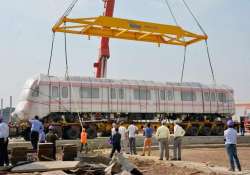Delhi Metro gets its first driver-less train from Korea
New Delhi: Delhi Metro today received its first driver-less train, equipped with several advanced features, from a Korea-based manufacturer, which will ply on sections of Phase-III of the network, set to be operational by next

New Delhi: Delhi Metro today received its first driver-less train, equipped with several advanced features, from a Korea-based manufacturer, which will ply on sections of Phase-III of the network, set to be operational by next year end.
The six-coach train that was ferried to India by sea, arrived at Gujarat's Mundhra port and was brought by road to Delhi on specially-made trailers.
A total of 20 such train sets of Hyundai Rotem will be manufactured in South Korea's Changwan by the end of this year while the remaining 61 are being manufactured at the Bharat Earth Movers Limited (BEML) plant in Bengaluru, the DMRC said.
They would run on the over 58 km-long Majlish Park-Shiv Vihar (Line 7) and the over 38 km-long Janakpuri (West)-Botanical Garden (Line 8) corridors of the Phase-III, and both these sections are expected to be operational by the end of 2016.
These new trains of Delhi Metro have undergone significant technological as well as eco-friendly upgrades and many additional features have been added to increase passenger comfort.
They are designed for a maximum speed of 95 kmph and operational speed of 85 kmph, Delhi Metro said. A DMRC official said that, although, initially drivers will be deputed for operating the trains they would be gradually withdrawn to move to Unattended Train Operation (UTO).
“These new-generation trains are suitable to eventually run on UTO mode, that is, train operators will not be required to operate these trains and the Operations Control Centres (OCC) of the Delhi Metro system will directly regulate the movement of the trains,” he said.
Each coach can accommodate maximum 380 passengers, which translates to 2,280 passengers in each train set of 6 coaches. The cabin-less trains would be able to accommodate 40 commuters more in a six coach train as the driver's cab will not be required in such trains.
“These trains would be more energy efficient than the earlier trains of Delhi Metro because of improved design features such as better regeneration of energy during braking, energy efficient sub systems like LED lighting and air conditioning systems,” the DMRC said.
